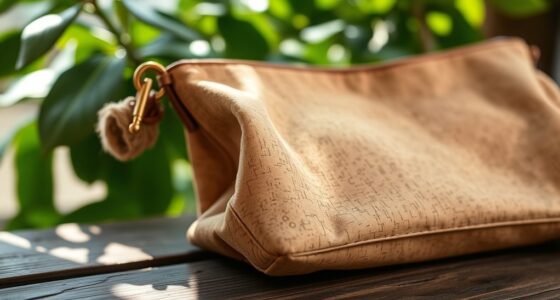When choosing between a hiking backpack and an urban backpack, consider where you’ll use it most. If you need something rugged, weather-resistant, and built for tough terrains, a hiking pack is your best bet. For city use, opt for a stylish, lighter bag that fits your daily needs. Think about durability versus appearance and where you’ll carry your bag most often. Keep exploring to uncover tips on making the perfect choice for your lifestyle.
Key Takeaways
- Consider outdoor durability features like water resistance, reinforced stitching, and rugged materials for hiking backpacks.
- Prioritize style, sleek design, and lighter fabrics if the backpack is mainly for urban, city, or casual use.
- Match your activity environment: rugged terrains and weather conditions favor hiking packs, while urban settings suit fashion-forward backpacks.
- Evaluate weight and versatility: lighter, versatile bags work well for daily urban errands; heavy-duty, durable packs are better for outdoor adventures.
- Check brand reputation for quality, ensuring the backpack meets both durability needs for outdoor use and aesthetic preferences for urban environments.

When choosing between a hiking backpack and an urban backpack, understanding your specific needs and activities is essential. Your decision hinges on how you plan to use the bag daily and during outdoor adventures. Durability comparisons play a significant role here, as hiking backpacks are built to withstand tough conditions—think rugged terrains, moisture, and rough handling. They typically feature reinforced stitching, high-denier fabrics, and weather-resistant materials that ensure longevity even after heavy use. Urban backpacks, on the other hand, prioritize style considerations alongside practicality. While some urban bags are surprisingly durable, they often focus more on sleek designs and fashionable appearances, which might compromise some aspects of rugged durability. If you’re someone who needs a bag that can handle daily commutes, city errands, and occasional outdoor trips, balancing these durability factors becomes key.
Choosing the right backpack depends on your needs—durability for outdoor adventures or style for urban life.
For outdoor pursuits, durability should be be a top priority. Hiking backpacks are designed with heavy-duty materials that resist tears, abrasions, and water intrusion, making them ideal for unpredictable weather and rough terrain. They also tend to have multiple compartments, reinforced zippers, and padded straps that add to their resilience and comfort during long hikes. Conversely, urban backpacks may use lighter fabrics to keep the overall weight down and focus on aesthetic appeal. While they can handle everyday wear and tear, they might not stand up as well under extreme conditions or frequent heavy use. If you’re planning for intense outdoor activities, a hiking backpack’s durability advantages outweigh those of a typical urban pack.
Style considerations also influence your choice. Urban backpacks come in a variety of trendy designs, colors, and materials designed to complement your fashion sense and fit into city life seamlessly. They often resemble designer handbags or sleek tech accessories, making them versatile for work, social outings, or casual settings. Hiking backpacks tend to favor function over fashion, with a more utilitarian appearance and fewer stylistic options. However, some brands now incorporate modern design elements into hiking packs, blending style with durability. If you value aesthetics and want a bag that looks good with your everyday wardrobe, an urban backpack might be the better pick. Conversely, if your priority is rugged performance and resilience for outdoor adventures, a hiking backpack’s utilitarian style and durable construction are more suitable.
Ultimately, your choice depends on balancing durability comparisons and style considerations relevant to your lifestyle. Think about where you’ll use the bag most often and what features matter most—whether it’s weather resistance and toughness or sleek design and versatility. Knowing these priorities helps you select a backpack that not only meets your needs but also lasts through daily wear or outdoor challenges. Additionally, considering brand reputation can help ensure you invest in a quality product that aligns with your durability and style expectations.
Frequently Asked Questions
How Do Waterproof Features Differ Between Hiking and Urban Backpacks?
You’ll find that hiking backpacks often use waterproof fabrics like ripstop nylon or polyurethane coatings to keep your gear dry during rain or creek crossings. Urban backpacks, on the other hand, usually rely on rain covers for added protection, which are easy to deploy when needed. While hiking packs prioritize built-in waterproof features, urban backpacks give you flexibility with removable rain covers for unpredictable weather.
What Security Features Are Common in Urban Backpacks?
Imagine you’re commuting in a busy city, and your backpack has anti-theft locks and RFID blocking pockets. These security features are common in urban backpacks to protect your valuables. Anti-theft locks secure zippers against pickpocketing, while RFID blocking prevents electronic theft of credit card information. Such features give you peace of mind during daily commutes, ensuring your belongings stay safe and private amidst the hustle and bustle.
Can Hiking Backpacks Be Used Effectively for Daily Commuting?
Yes, hiking backpacks can be used effectively for daily commuting. Their versatility makes them practical, with features like multiple compartments and sturdy construction that help you stay organized and comfortable. You’ll appreciate the durability for daily use, and many hiking backpacks include laptop sleeves and water-resistant materials, making them suitable for urban environments. Just choose one with the right size and features to match your commuting needs.
How Do Weight Distribution Systems Vary Between the Two Backpack Types?
You might worry that weight distribution systems are too complex, but both types use load bearing straps and frame support systems to keep weight balanced. Hiking backpacks often feature adjustable load lifters and padded hip belts for better weight transfer, while urban backpacks rely on streamlined frame support and ergonomic straps for comfort. These systems help you carry loads efficiently, whether trekking rugged trails or maneuvering city streets.
Are There Specific Materials Preferred for Durability in Urban Settings?
For durability in urban settings, you prefer materials like ballistic nylon or polyester, which are trendy and withstand daily wear and tear. These materials align with current fashion trends, offering sleek, stylish looks without sacrificing strength. Plus, many brands now focus on material sustainability, so you can choose eco-friendly options that support environmental efforts. This way, your urban backpack remains durable, fashionable, and environmentally conscious.
Conclusion
Choosing between a hiking and urban backpack comes down to what you need—adventure or everyday ease. While a hiking backpack offers durability and space for outdoor gear, an urban backpack provides style and convenience for daily commutes. Both suit different worlds; one prepares you for rugged trails, the other for city streets. Whichever you pick, it’s about blending function with your lifestyle, turning your daily journey into an effortless adventure.









